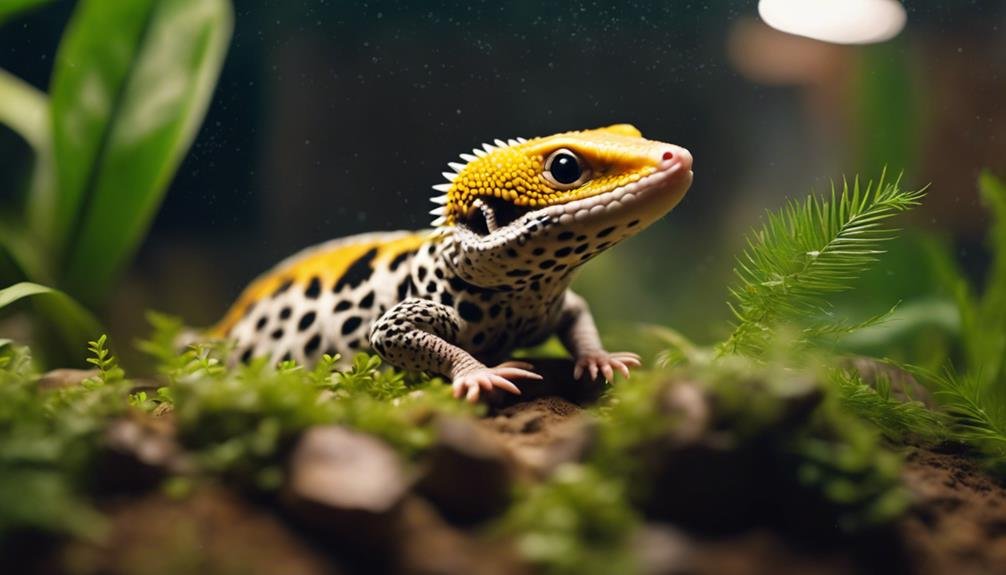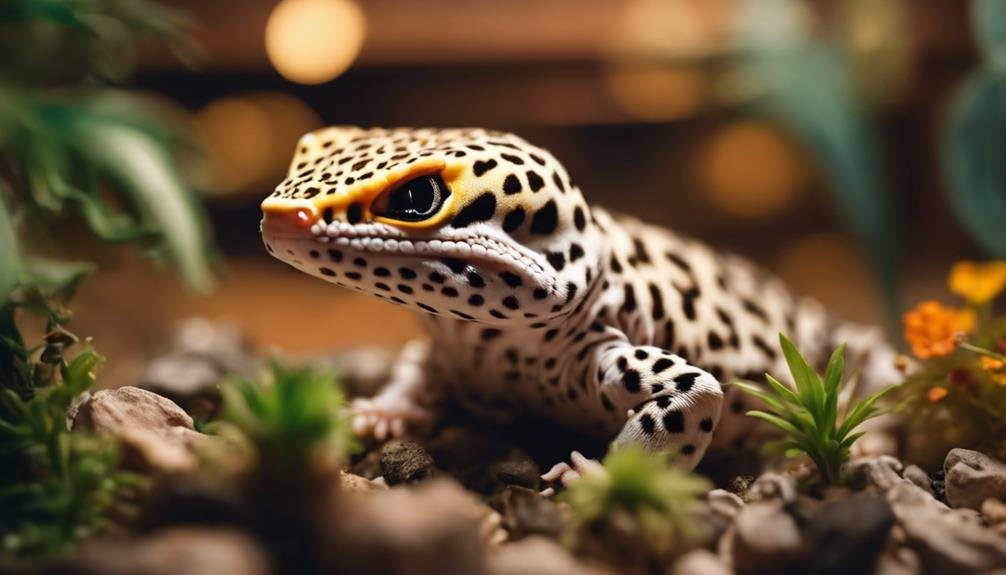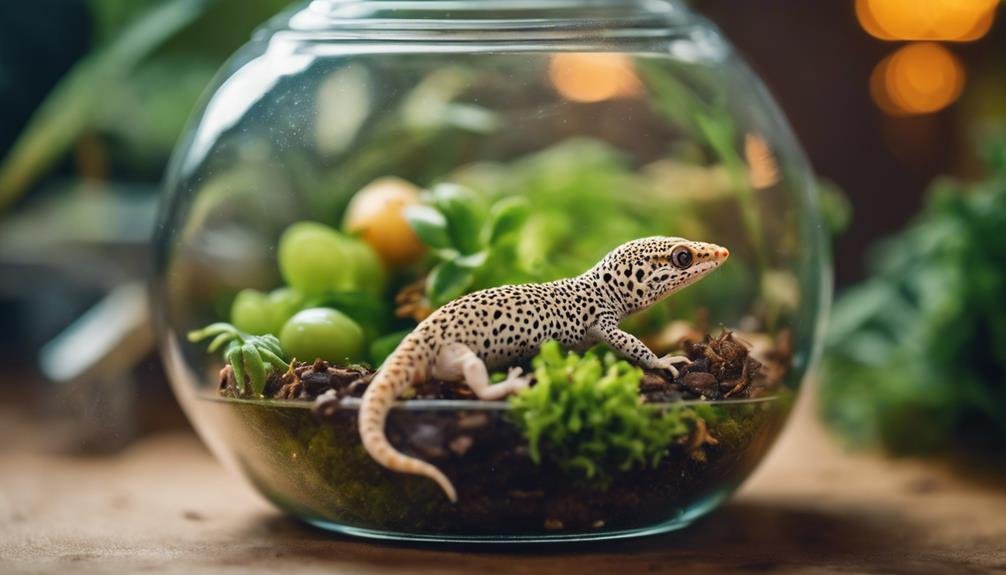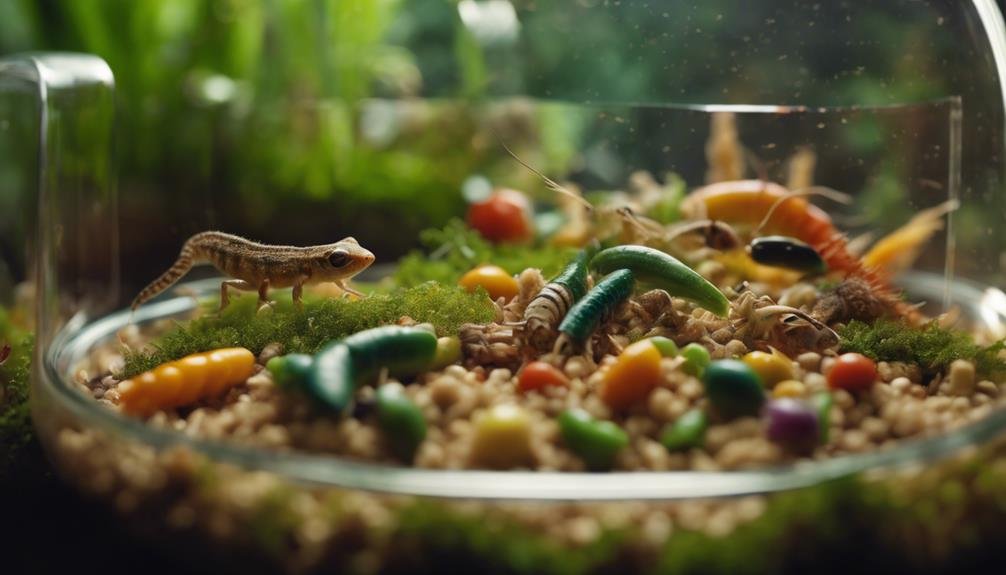When caring for leopard geckos, you’ll find their dietary needs are quite specific, focusing mainly on live insects. Crickets and mealworms are the cornerstone of their diet, but it’s important to provide variety to guarantee balanced nutrition. You might wonder about the right insect sizes, safe treats, and why fruits and vegetables should be avoided. Additionally, understanding the importance of gut-loading insects and supplementing their diet can greatly impact their health. So, how do you ensure your leopard gecko gets everything it needs to thrive? Learn about What Do Leopard Geckos Eat?
Key Takeaways
- Leopard geckos primarily eat live insects such as crickets and mealworms.
- A variety of insects is crucial for a balanced diet.
- Waxworms and superworms can be given as occasional treats.
- Avoid feeding leopard geckos fruits and vegetables.
- Gut loading and supplement dusting enhance the nutritional value of feeder insects.
Insect Diet Basics


Leopard geckos thrive on a diet primarily consisting of live insects like crickets and mealworms. These insects should form the staple of your gecko’s diet, as geckos are insectivores and rely on the protein and nutrients found in their prey.
When you think about ‘Insects For Your Leopard,’ remember that variety is key. Crickets and mealworms are great, but you can also occasionally feed your gecko other insects like waxworms and superworms. However, treats like waxworms and superworms should be given sparingly because of their high fat content.
You might wonder, ‘How often should I feed my leopard gecko?’ The frequency and amount of food depend on your gecko’s age and health status. Younger geckos must eat more frequently, usually daily, while adults can be fed every other day. Always provide live insects, as they stimulate your gecko’s natural hunting instincts.
It’s essential to note that fresh fruits and vegetables shouldn’t be part of their diet. Since leopard geckos are insectivores, their digestive systems aren’t designed to process plant matter. So, when you think, ‘How best to feed my leopard?’ stick to live insects for their health.
Appropriate Insect Sizes
When feeding your leopard gecko, ensure the insects are smaller than the space between its eyes to prevent choking hazards. This important rule is essential for your pet’s health, ensuring it can safely consume its meals without any risk of choking or digestion issues.
Choosing the appropriate insect for your leopard gecko depends on age and size. Here are some guidelines to help you:
- Young Geckos: Opt for smaller insects like pinhead crickets or small mealworms. These are manageable for their developing jaws and digestive systems.
- Adult Geckos: Larger insects, such as adult crickets or superworms, are suitable. However, always double-check that the insects are still smaller than the space between their eyes.
- General Rule: If in doubt, always go for smaller insects. This is a safe choice to prevent choking and potential digestion issues.
Live Insect Options


Your leopard gecko’s diet should primarily consist of live insects like crickets and mealworms, which provide essential nutrients and stimulation. Crickets are a staple because they’re nutritious and encourage your gecko to exercise by hunting. Mealworms offer another excellent option: rich in protein and easy to store.
Mix up these options occasionally to guarantee your gecko gets a balanced diet. Waxworms, although high in fat, can be given as occasional treats. Superworms are another treatment option but should also be fed sparingly due to their high-fat content and larger size. Remember, variety in live insects helps mimic a natural diet and keeps your gecko healthy.
Here’s a quick comparison of the main live insect options:
| Insect Type | Nutritional Value | Feeding Frequency |
|---|---|---|
| Crickets | High in protein | Daily staple |
| Mealworms | Protein-rich | Daily staple |
| Waxworms | High in fat | Occasional treat |
| Superworms | High in fat | Occasional treat |
Providing various live insects ensures your leopard gecko stays healthy and keeps it engaged and active. Always choose appropriately sized insects to prevent choking hazards and ensure easy digestion.
Treats and Their Frequency
Treats like waxworms and superworms should be offered sparingly to avoid unhealthy weight gain in leopard geckos. Their high fat content can lead to obesity if given too frequently. While spoiling your gecko with these tasty morsels is tempting, moderation is essential for their health.
To maintain a balanced diet for your leopard gecko, follow these guidelines:
- Frequency: Offer treats like waxworms and superworms only occasionally, perhaps once every couple of weeks.
- Quantity: Limit the number of treats to one or two pieces per session to prevent excessive calorie intake.
- Monitor Weight: Regularly check your gecko’s weight and adjust treatment frequency if you notice any signs of unhealthy weight gain.
Treats should complement, not replace, the primary diet of live insects like crickets and mealworms. These insects provide the necessary nutrients that your leopard gecko needs to thrive. By sparing treats, you ensure your pet remains healthy and active.
Incorporating treats into your gecko’s diet can be beneficial when done correctly. Just monitor the frequency and quantity to maintain their peak health. Enjoy watching your gecko relish these occasional treats, but always prioritize their overall well-being.
Avoiding Fruits and Vegetables


Leopard geckos shouldn’t be fed fruits and vegetables because their digestive systems aren’t designed to process plant matter. As insectivores, their natural diet consists exclusively of live insects. Feeding them fruits and vegetables can lead to serious health issues, including digestive blockages and nutritional deficiencies. Leopard geckos thrive on a diet of live insects such as crickets, mealworms, and the occasional waxworm or superworm.
Sticking to a balanced diet of live insects is important to ensure your leopard gecko gets all the necessary nutrients. Fruits and vegetables don’t provide the protein and other essential nutrients for their well-being. While it might be tempting to offer a varied diet, remember that what works for humans or other pets doesn’t apply to leopard geckos.
Offering live insects ensures they engage in natural hunting, which is vital for their mental stimulation and physical health. Avoid the mistake of thinking that fruits and vegetables can be a healthy treat for your gecko. They’re strictly insectivores; their diet should reflect that for the best health and longevity. Stick to live insects and keep your leopard gecko happy and healthy.
Supplementing Diet
Adding calcium powder to your leopard gecko’s diet is vital for maintaining their health and preventing metabolic bone disease. Calcium guarantees a proper calcium-phosphorus balance, which is important for your gecko’s bone strength and overall well-being.
To keep your pet healthy, follow these guidelines for supplementing their diet:
- Calcium Powder: Dust your gecko’s insects with calcium powder at every feeding. This will help them get the necessary nutrients for strong bones.
- Multivitamin Powder: Occasionally, they dust their food with multivitamin powder to provide additional essential nutrients. These vitamins support overall health and can prevent deficiencies.
- All-in-One Powders: Use all-in-one powders that combine calcium, vitamins, and other nutrients. These are convenient and ensure your gecko gets a balanced mix of necessary nutrients.
If your gecko doesn’t have access to UVB lighting, you’ll need to include D3 supplementation in their diet more frequently. D3 helps in calcium absorption; without it, your gecko could suffer health issues.
However, if you provide UVB lighting, they can produce vitamin D3, and you’ll need to supplement it less often.
Gut Loading Insects


Guaranteeing your leopard gecko gets the utmost nutrition from their diet involves supplementing with powders and gut-loading the insects you feed them. Gut loading means feeding the insects nutritious foods before offering them to your gecko. This process greatly enhances the nutritional value of the insects, making them a more wholesome meal for your pet.
Before feeding insects to your leopard gecko, offer them a diet of leafy greens, fruits, and other healthy foods. This practice ensures that when your gecko consumes the insects, they also ingest these nutrients. You can also use commercial gut load diets like Repashy SuperLoad to maximize the benefits. These products are specifically designed to boost the nutritional content of feeder insects.
Gut loading complements supplement dusting, creating a well-rounded diet that supports your gecko’s overall health. While supplement dusting directly adds essential vitamins and minerals to the insects, gut loading ensures the insects are packed with nutrients. This dual approach helps keep your leopard gecko in excellent condition, promoting better growth and vitality.
Toxic Foods to Avoid
Knowing which foods are toxic and should be avoided when feeding your leopard gecko is vital. Providing the wrong diet can pose serious health risks to your gecko, so it’s important to be informed.
Here are three key things to avoid:
- Insects with Pesticides: Wild-caught insects might seem like a natural choice, but they can carry pesticides or fertilizers harmful to leopard geckos. These chemicals can lead to severe health issues or even be fatal. It’s safer to stick with store-bought insects that are specifically bred for reptile consumption.
- Toxic Insects: Some insects are inherently harmful to leopard geckos. For example, hornworms can be fatal if ingested. Always research any new insect before adding it to your gecko’s diet to ensure it’s safe.
- Dead or Processed Foods: Leopard geckos thrive on fresh, live prey. Dead, dried, or processed foods lack the necessary nutrients and can lead to malnutrition. Fresh live prey is crucial for their best nutrition and overall well-being.
Monitoring Feeding Habits
To keep your leopard gecko healthy, closely monitor their feeding habits for irregularities. Regular monitoring is vital for their overall health. Keep a log of the amount of live insects your gecko consumes. This helps you gauge their appetite and detect any issues early on.
Please pay attention to changes in their eating behavior. If your gecko suddenly eats less or shows disinterest in live insects, it could be a sign of stress or illness. It’s important to ensure they’re actively hunting and consuming their prey. A healthy leopard gecko will enthusiastically chase and eat live insects, so any deviation from this behavior warrants closer examination.
Additionally, note any significant decrease in your gecko’s appetite. If they’re eating noticeably less over a period, it might be time to consult a veterinarian. Sometimes, environmental factors like temperature or humidity can affect their feeding habits, so make sure their habitat is at its best. Regularly checking and adjusting these conditions can help maintain your gecko’s appetite and overall health.
Conclusion
So, when feeding your leopard gecko, stick to various appropriately sized live insects like crickets and mealworms as their main diet. Treats like waxworms are fine occasionally, but don’t overdo it.
Avoid fruits and veggies; make sure to gut-load and dust the insects with supplements.
Monitor their feeding habits to ensure they’re healthy and happy. Following these tips will keep your gecko thriving!


